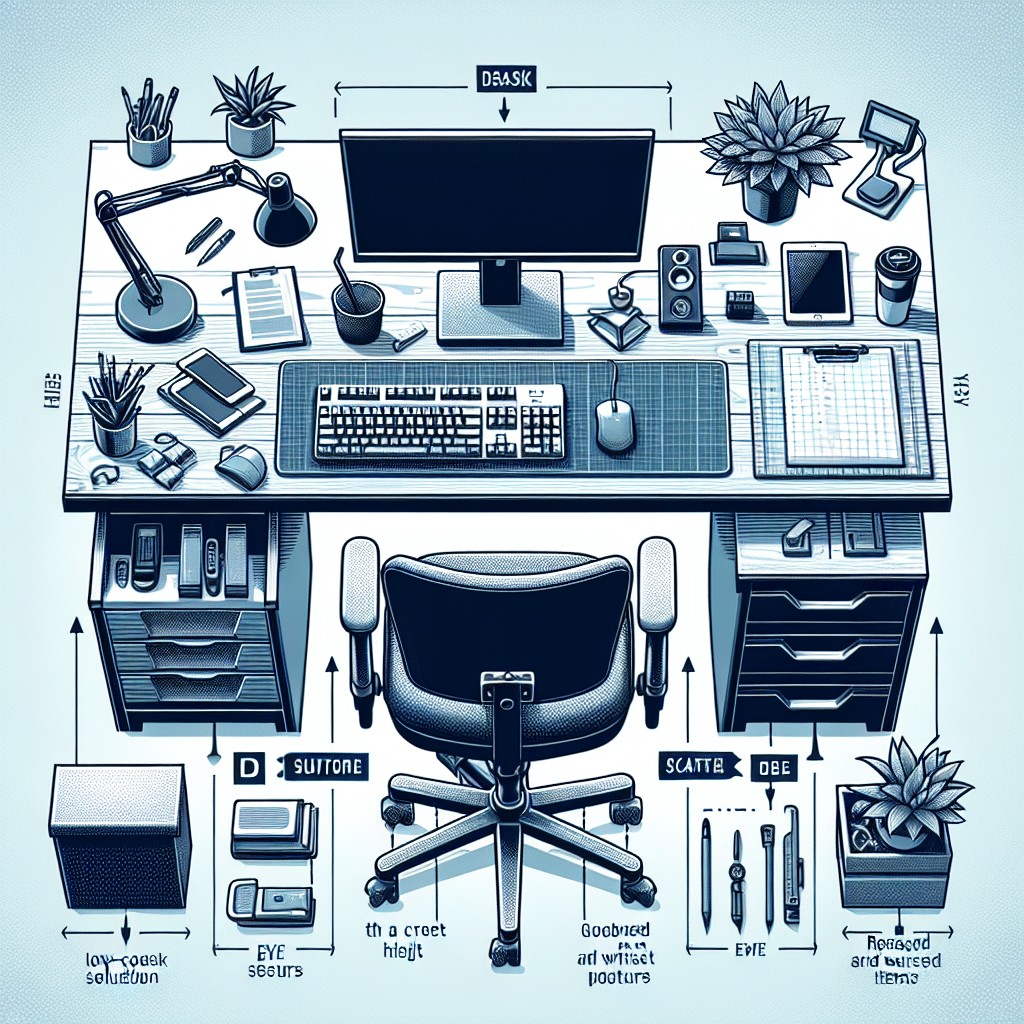Understanding Ergonomics in a Budget-Friendly Workstation
Creating an ergonomic workstation is essential for enhancing comfort, productivity, and overall well-being. The term ‘ergonomics’ pertains to designing a workspace that fits the individual user. In cases where budget constraints exist, it’s entirely possible to foster an ergonomic environment without overspending.
Assess Your Workspace
Before making any purchases or adjustments, assess your current workspace. Here are key aspects to evaluate:
- Chair Height: Your feet should rest flat on the ground or on a footrest.
- Monitor Position: The top of your monitor should be at or just below eye level.
- Keyboard and Mouse Placement: Both should be close enough for your arms to rest comfortably at about a 90-degree angle.
- Desk Space: Ensure you have enough room for all your essential tools.
Choose the Right Chair
Investing in a good chair is crucial, yet it doesn’t have to break the bank. Consider these options:
- Second-Hand Office Chairs: Look for those with good lumbar support. Websites like Craigslist or local thrift stores may have quality finds.
- DIY Cushions: If your chair lacks support, consider using memory foam cushions or even rolled towels to provide extra lumbar support.
- Adjustable Chairs: Opt for a chair with basic height adjustments; this ensures you can find your comfort level.
Monitor Placement and Stands
Monitor placement is vital for reducing eye strain and neck pain. Here’s how to achieve the ideal setup affordably:
- Books or Boxes: Use available books or sturdy boxes to elevate your monitor. The goal is to position the monitor screen so the top edge is at eye level.
- Budget Monitor Stands: You can purchase inexpensive stand risers or create a customized stand using wood or other materials.
- Dual Monitors: If you use dual monitors, make sure they are the same height and aligned. Stacking them is often not ergonomic; instead, use separate stands.
Ergonomic Keyboards and Mice
Your keyboard and mouse play a significant role in preventing strain:
- Ergonomic Keyboard: Look for budget ergonomic keyboards that split the keys and allow for a more natural wrist position.
- DIY Wrist Support: Make an effective wrist rest with a rolled-up towel or a small pillow to support your wrist height.
- Opt for Vertical Mice: If you can find one on sale, a vertical mouse reduces forearm twisting and promotes a more natural hand position.
Desk Height Adjustments
Your desk height should allow your elbows to rest at roughly a 90-degree angle. If your desk is too high or low, consider these solutions:
- Height-Adjustable Desks: While new adjustable desks can be pricey, consider DIY modifications. Ensure your desk accommodates both sitting and standing levels by using adjustable legs or raising it with wood blocks.
- Portable Laptop Stand: For those using laptops, a simple portable stand can adapt the height as needed while improving airflow and preventing overheating.
Lighting Conditions
Poor lighting can lead to headaches and decreased productivity:
- Natural Light: Position your workstation near a window. Natural light can be uplifting and helps reduce eye strain.
- Desk Lamps: Invest in an affordable adjustable desk lamp with LED bulbs for optimal lighting. Choose a model that reduces glare on your screen.
Managing Cables and Clutter
A clutter-free environment fosters productivity:
- Cable Management: Use inexpensive cable clips or even binder clips to keep cords organized and out of the way.
- Minimalistic Approach: Limit desk items to essential tools, allowing for more available workspace.
Organize for Efficiency
Tools should be within arm’s reach to reduce repetitive strain:
- In-Desk Organization: Utilize drawer organizers or desktop bins to store frequently used supplies.
- Use Vertical Space: Install shelves to elevate your supplies and declutter your workspace.
Incorporate Movement into Your Day
An ergonomic workstation isn’t just about how you sit; it includes how you move:
- Frequent Breaks: Set a timer to remind you to stand and stretch every 30-60 minutes.
- Incorporate Stretching: Use online resources for quick stretching exercises specifically focused on the neck, back, and shoulders.
Customization Options
Personalize your workspace to enhance comfort and inspiration.
- Mood Board: A small corkboard can keep important reminders in sight while adding personality.
- Plants: Adding low-maintenance indoor plants can improve air quality and boost your mood.
Utilizing Technology
Leverage technology to assist in creating a functional workstation:
- Apps for Posture: Download apps that remind you to maintain good posture or take breaks.
- Document Scanners: Use your smartphone to scan important documents rather than stacking them on your desk.
Ergonomic Accessories without the Price Tag
Certain accessories can improve your workspace at reasonable prices:
- Phone Stand: Keep your phone at eye level with a simple stand to minimize neck strain.
- Footrest: If your feet don’t reach the ground, a footrest can greatly improve comfort. A thick book or footstool works perfectly.
Sleep and Health Considerations
Ensure your workspace considers health beyond comfort:
- Sleep Quality: A well-designed workstation can improve productivity, but remember to prioritize adequate sleep to maintain overall health.
- Hydration: Keep a water bottle nearby to remind yourself to stay hydrated.
Community Resources
Explore local resources or community programs:
- Library Resources: Many public libraries have resources for ergonomic workstations and may even lend ergonomic equipment.
- Workplace Programs: Some employers offer ergonomic consultations or resources—check your HR policy.
By thoughtfully assessing your existing workspace and implementing effective ergonomic strategies, you can create a comfortable, productive workstation on a budget. All it requires is a little creativity, resourcefulness, and commitment to maintaining a healthy work lifestyle.
